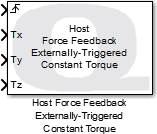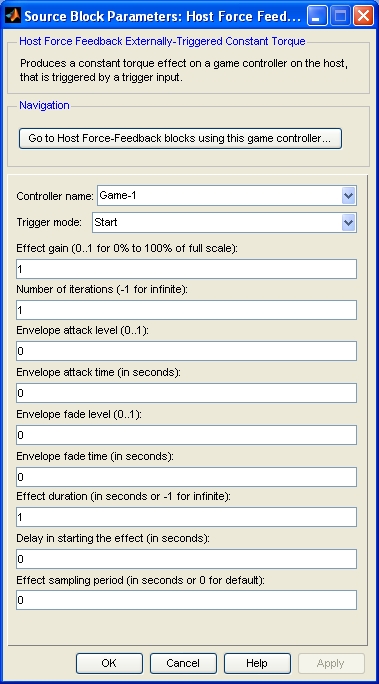

Host Force Feedback Externally-Triggered Constant Torque
Produces a constant torque effect on a game controller on the host that is triggered by an input signal.
Library
QUARC Targets/Devices/Peripherals/Host/Force Feedback Game Controllers/Constant Force Effects MATLAB Command Line Click to copy the following command line to the clipboard. Then paste it in the MATLAB Command Window: qc_open_library('quarc_library/Devices/Peripherals/Host/Force Feedback Game Controllers/Constant Force Effects')
Description

The Host Force Feedback Externally-Triggered Constant Torque block produces a steady torque on the host game controller in response to the rising edge of the Trigger input. The block may be configured to stop the effect on the falling edge of the trigger signal.
The Tx, Ty and Tz inputs define a torque vector whose magnitude and direction determines the magnitude and direction of the torque applied by the game controller. The magnitude and direction of this torque are updated every time the trigger occurs, according to the inputs to the block. The parameters of the block determine the temporal characteristics of the effect, such as the duration and envelope. A Host Force Feedback Game Controller block must be present in the model to configure the game controller.
Limitations
Unused axes
 Unused axes should be left unconnected or connected to the
Ground
MATLAB Command Line
Click to copy the following command line to the clipboard. Then paste it in the MATLAB Command Window:
doc('Ground') block. Do not connect unused axes to any other type of block because doing so will require a game controller with all the
connected axes. For example, if the Tx, Ty and Tz inputs are all connected then the game controller will need to support all three axes in order for the effect to be rendered.
Unused axes should be left unconnected or connected to the
Ground
MATLAB Command Line
Click to copy the following command line to the clipboard. Then paste it in the MATLAB Command Window:
doc('Ground') block. Do not connect unused axes to any other type of block because doing so will require a game controller with all the
connected axes. For example, if the Tx, Ty and Tz inputs are all connected then the game controller will need to support all three axes in order for the effect to be rendered.
Level of support
 Not all force feedback game controllers will support a constant torque effect that is triggered by a signal. If externally-triggered constant torque effects are supported, a game controller may not
support all the axes or features of this block.
Not all force feedback game controllers will support a constant torque effect that is triggered by a signal. If externally-triggered constant torque effects are supported, a game controller may not
support all the axes or features of this block.
Input Ports
Trigger
The signal used to start or stop the effect. Refer to the Trigger mode parameter for details.
Tx
The normalized torque to apply about the X axis (-1.0=-maximum, 0.0=no torque, 1.0=+maximum). The positive X direction is from left to right. If this axis is unused, connect it to a Ground MATLAB Command Line Click to copy the following command line to the clipboard. Then paste it in the MATLAB Command Window: doc('Ground') block or leave it unconnected.
Ty
The normalized torque to apply about the Y axis (-1.0=-maximum, 0.0=no torque, 1.0=+maximum). The positive Y direction is from back to front. If this axis is unused, connect it to a Ground MATLAB Command Line Click to copy the following command line to the clipboard. Then paste it in the MATLAB Command Window: doc('Ground') block or leave it unconnected.
Tz
The normalized torque to apply about the Z axis (-1.0=-maximum, 0.0=no torque, 1.0=+maximum). The positive Z direction is from up to down. If this axis is unused, connect it to a Ground MATLAB Command Line Click to copy the following command line to the clipboard. Then paste it in the MATLAB Command Window: doc('Ground') block or leave it unconnected.
Output Ports
This block has no output ports.
Parameters and Dialog Box

Controller name
The identity of the associated Host Force Feedback Game Controller block. The Host Force Feedback Externally-Triggered Constant Torque block must be associated with a Host Force Feedback Game Controller block.
Trigger mode
The function of the trigger input to the block. If this parameter is set to "Start" then a rising edge at the trigger input will start the effect. The effect will stop when the effect duration has expired. A falling edge at the trigger input will be ignored.
If this parameter is set to "Start/Stop" then a rising edge at the trigger input will also start the effect. However, the effect will stop when the effect duration has expired or a falling edge is seen at the trigger input.
Effect gain (tunable online)
A normalized gain to apply to the effect. The torques are scaled by this gain before being applied to the device. The gain must be a fraction between 0 and 1 inclusive. This parameter is useful for scaling effects for a different game controller.
Number of iterations (tunable online)
The number of times to play the effect in sequence. The envelope is re-articulated with each iteration. If this value is -1 then the effect is played indefinitely.
Envelope attack level (tunable online)
The normalized magnitude (0.0=no torque, 1.0=maximum) of the torque at the beginning of playback.
Envelope attack time (tunable online)
The amount of time in seconds for the magnitude of the effect to ramp linearly from the attack level to the sustain level. The sustain level is the magnitude of the torque specified at the block inputs. This parameter may be zero.
Envelope fade level (tunable online)
The normalized magnitude (0.0=no torque, 1.0=maximum) of the torque at the end of playback.
Envelope fade time (tunable online)
The amount of time in seconds for the magnitude of the effect to ramp linearly from the sustain level to the fade level. The sustain level is the magnitude of the torque specified at the block inputs. This parameter may be zero.
Effect duration (tunable online)
The total duration of the effect in seconds. It should be larger than sum of the envelope's attack and fade times. The difference between the effect duration and the sum of the attack and fade times determines the time for which the sustain level is maintained.
Delay in starting the effect (tunable online)
The time in seconds to delay starting the effect after the trigger has occurred.
Effect sampling period (tunable online)
The sampling period of the effect in seconds. This parameter determines the sampling period of the effect on the device itself. It is not related to the sample time of this block. If this value is zero, the default sampling period is used.
Targets
|
Target Name |
Compatible* |
Model Referencing |
Comments |
|---|---|---|---|
|
Yes |
Yes |
||
|
Yes |
Yes |
||
|
Yes |
Yes |
||
|
Yes |
Yes |
||
|
Yes |
Yes |
||
|
Yes |
Yes |
||
|
Yes |
Yes |
||
|
Yes |
Yes |
||
|
Yes |
Yes |
||
|
Yes |
Yes |
||
|
Yes |
Yes |
||
|
Yes |
Yes |
||
|
Yes |
Yes |
||
|
Yes |
Yes |
Last fully supported in QUARC 2018. |
|
|
Rapid Simulation (RSIM) Target |
Yes |
Yes |
|
|
S-Function Target |
No |
N/A |
Old technology. Use model referencing instead. |
|
Normal simulation |
Yes |
Yes |
See Also

Copyright ©2025 Quanser Inc. This page was generated 2025-11-01. Submit feedback to Quanser about this page.
Link to this page.